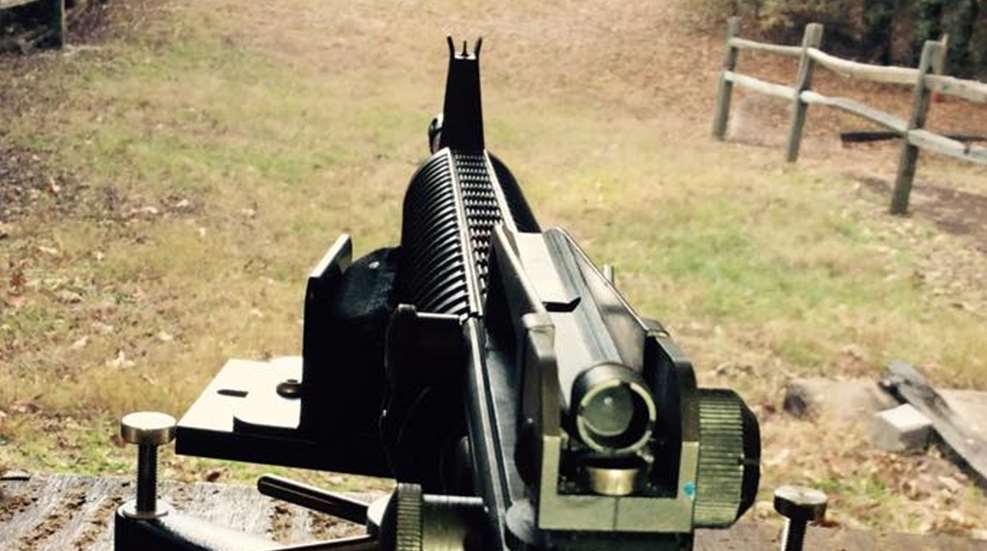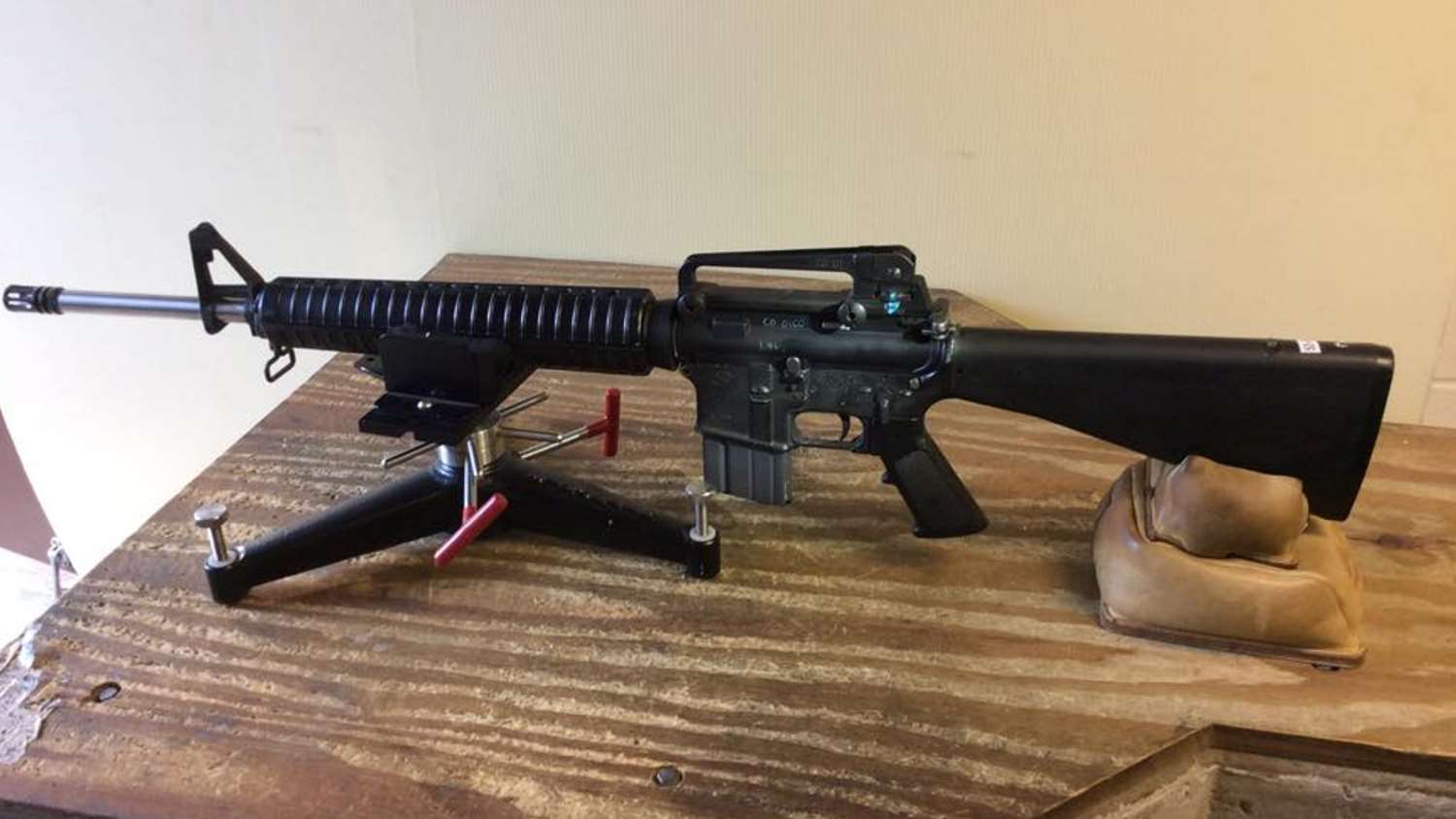
WARNING: All technical data in this publication, especially for handloading, reflect the limited experience of individuals using specific tools, products, equipment and components under specific conditions and circumstances not necessarily reported in the article and over which the National Rifle Association (NRA) has no control. The data has not otherwise been tested or verified by the NRA. The NRA, its agents, officers and employees accept no responsibility for the results obtained by persons using such data and disclaim all liability for any consequential injuries or damages.
Above: The details of an accurized, hooded M16 rear sight with interchangeable apertures.
In this article, we conclude our discussion of accuracy testing Service and Match Rifles using iron sights.
In previous articles, we discussed several topics including the background and theory of testing with iron sights, the importance of sight alignment vs. sight picture and selecting optimum target sizes to facilitate accuracy in testing. Here, we’ll cover aspects of the aiming method.
Point of Aim: Center Hold, vs. 6 O’clock, vs. “Line of White,” vs. …
Individual shooter’s preferences vary re: their hold method—i.e., where they aim on the target. Part of this is related to their eyesight, and part may be related to their training, especially for offhand and rapid fire. Some shooters feel very comfortable in offhand and rapid fire when holding in the center of the black.
This hearkens back to the “sight alignment vs. sight picture” emphasis. If their eyesight allows them to distinctly see the front sight post against the relatively fuzzy aiming black, then with properly-aligned sights, any shot fired while within their minimum arc of movement—and while in the black—will be a good shot. This allows them to work more on sight alignment and less on sight picture. It can also help speed recovery between shots during rapid-fire (especially important with rifles of heavier recoil).
Others, whether due to eyesight that requires a sharp contrast between the target and the front sight, or due to training preferences, use a six o’clock hold. Here, the top flat of the post front sight is placed exactly at the bottom edge of the aiming black, which gives a very precise aiming point. Some are comfortable with this method in offhand, rapid-fire, or both, and find it improves their precision.
Still others prefer a “line of white” hold, which allows a thin, consistent line of white between the top of the front sight and the bottom edge of the black. This helps avoid a tendency of the front sight to creep up into the black slightly, unnoticed.

When shooting from the bench, it may be very easy to get an excellent sight picture with high contrast between the front post and the target using the six o’clock hold or line of white. Without the rifle’s moving due to shooting from position, the bench’s steadiness may make this preferable vs. a shooter’s normal hold in competition.
Experimentation with methods to determine what works best is helpful. Whatever method one uses, it is very important to do things consistently every time. Eye relief, placement of the head on the stock and pressure of the cheek on the comb are all important, in addition to the other technique factors discussed earlier in this series.
One’s choice of iron sight dimensions—both aperture (front and rear) and Service Rifle sights (post width, rear aperture diameter) is highly personal and much depends on the shooter’s eyesight.
Early in his Service Rifle career, this writer took his rifle to a 100 yard range and set up a correctly-scaled 100-yard reduced target. After firing eight groups with match ammo from the bench using a full-width NM front sight, he installed a 0.020” narrower front sight. After resting a bit, 8 more groups with the same ammunition proved very instructive.
... It’s important to blacken the front and rear sights to prevent glare and glint. This can be done with commercial sprays, an old-fashioned carbide lamp, or even the smoke from a burning MRE spoon (field expedient!).
The two eight group averages were identical to within 0.1-inch. However, the author had to work much harder to focus on the narrow front sight, which would contribute to eye fatigue and distraction. From then on, he used the standard-width NM front sight with good results. Other members of his team, blessed with eagle-like eyesight, preferred the narrower sights and performed extremely well with them.
Due to the effects of light on the sights, it’s important to blacken the front and rear sights to prevent glare and glint. This can be done with commercial sprays, an old-fashioned carbide lamp, or even the smoke from a burning MRE spoon (field expedient!). If possible, shooting under overhead cover also improves consistency, helping prevent variable light conditions on the sights that would affect accuracy or changes in sight picture.
Testing From Position Rather Than the Bench
Any number of rifle competitors shoot so much from position, and so little (or never) from a bench, that they are not comfortable managing the rifle on a benchrest. These shooters may have such confidence in their ability to shoot consistently and accurately either from a sling, prone, or with a sling and front sandbag, prone, that they prefer this to using a benchrest.
If capable of meaningfully testing their rifle and ammo’s accuracy, this is perfectly fine. However, for those comfortable with it, bench testing allows shooters whose sight alignment and position skills aren’t as advanced to do good work also.
Statistics: Group Sizes, Distances, Sample Sizes
How many groups should we fire, and how many shots per group? These questions are matters of judgment, to a degree. First, to best assess how one’s ammunition will perform in competition, it should be test-fired at the actual distance for which it will be used. I.e., 600 or 1000 yard ammo should be tested at 600 and 1000 yards, respectively, if possible. It is possible to work up very accurate ammunition at 100 or 200 yards that does not perform well as ranges increase. Sometimes, a change in powder can correct this and produce a load that really shines at longer range.
The number of shots fired per group should be realistic for the course of fire. That is, if one will be firing ten shot strings in competition, then final testing, at least, should involve 10-shot strings to reflect the true capability of the rifle. Knowing this will help the shooter better decide in competition whether a shot requires a sight adjustment, or if it merely struck within the normal accuracy radius of his rifle.
Many years ago, the author met a shooter who gleefully spoke of his “half-minute accurate M1A.” As this would have been a rather fine and rare specimen, the author inquired further. The shooter then retrieved a small group from his wallet … consisting of only three rounds fired!
He enjoyed deluding himself about the true accuracy of his M1A, certainly. However, this didn’t help him on the range when he had decisions to make based on knowing the rifle’s actual capability.
Finally, how many groups should be considered a valid test? Here, much depends on the precision with which one can gather the accuracy data. If shooting from a machine rest in good weather conditions, two or three 10-shot groups at full distance may be very adequate. If it’s windy, the rifle or ammunition are marginal, or the shooter is not confident in his ability to consistently fire every shot accurately, then a few more groups may give a better picture of the rifle’s true average.
Elevation and Windage Adjustment Verification
It is just as important to verify the true value and repeatability of one’s peep sight adjustments as it is to verify those of a scope. This can be done using a quality dial indicator to track the aperture’s movement with the rifle held steady in a fixture or vise. Test the elevation and windage adjustments, looking for uneven click values and for “dead” clicks that don’t affect the zero as expected.
Likewise, check for sight backlash, in which the shooter adjusts the sight back to a previous position, but the clicks don’t give the correct value upon reversing. Small, preliminary steps such as these can prevent a tremendous amount of frustration and head-scratching on the range.
With iron sights, the sight radius—i.e., the distance from front to rear sight – affects the click value. Thus, it is entirely possible for one match aperture sight to have 1/4, 1/3, or even 1/2-minute of angle adjustments, depending upon how far apart the sights are mounted. Sight manufacturers provide information on the ideal distance between sights to produce the desired fineness of adjustment. When acquiring a rifle that’s been already built, this should be taken into consideration.
Thus ends Part 6 in our series on accuracy testing and chronographing. In our next article, we’ll explore using chronographs to measure bullet speed and obtain useful trajectory and wind data for our ammunition.
SSUSA thanks the U.S. Army Marksmanship Unit for allowing the reprint of this article.


































